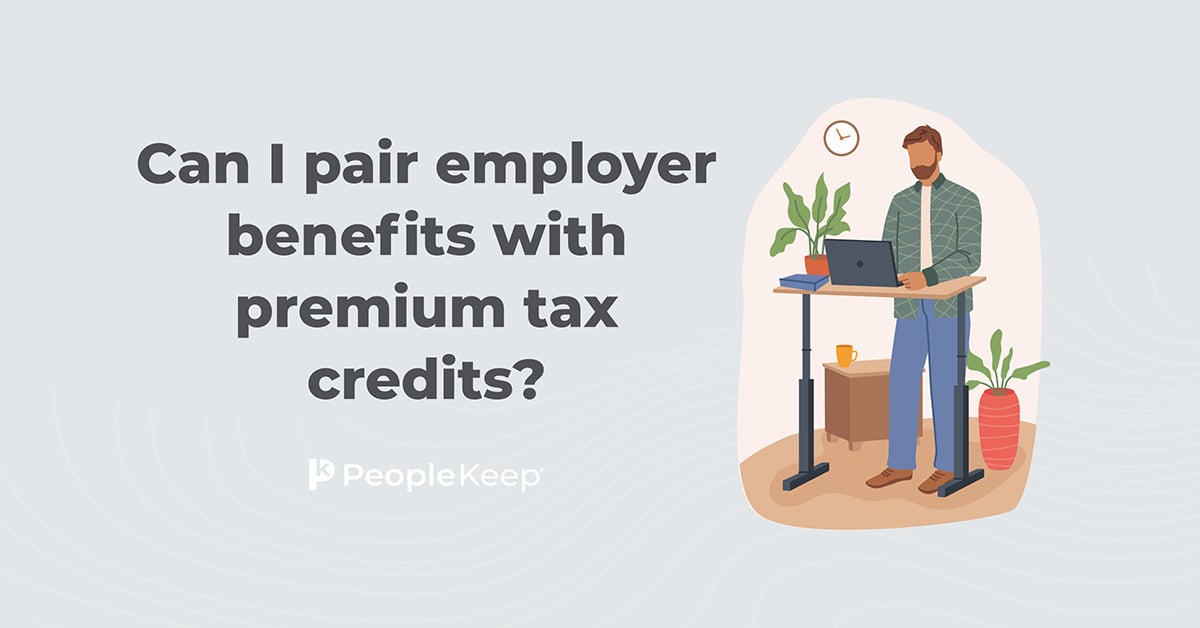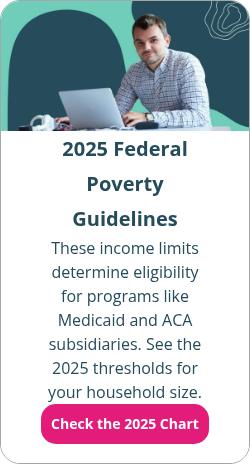What is a health insurance subsidy?
By Elizabeth Walker on August 30, 2024 at 11:23 AM
Whether you’re a small employer or an individual, you probably want to reduce your healthcare costs. Rising premium rates and unexpected out-of-pocket expenses can make medical care challenging to budget for. Luckily, the federal government created health insurance subsidies to help eligible individuals and business owners afford a health plan.
Different types of subsidies are available based on whether you’re an individual or a small employer, where you shop for healthcare, and where you live. But in any case, you must understand how subsidies work before determining if you qualify for one.
This blog post will explain health insurance subsidies, their various types, and how they can help you lower your medical costs.
In this guide, you’ll learn:
- Which health insurance subsidies are available through the ACA marketplace and specific states.
- Eligibility requirements for subsidies.
- How employers can use health reimbursement arrangements (HRAs) to help employees with their healthcare costs.
What is a health insurance subsidy?
A health insurance subsidy is a credit from the federal or state governments. It lowers the amount of a consumer’s monthly premium or other out-of-pocket costs. If you qualify for a subsidy, your health insurance costs can be much more affordable.
There are various types of health insurance subsidies, such as the following:
- Under the Affordable Care Act (ACA), subsidies help lower-income people without employer-sponsored health insurance or who are ineligible for Medicare or Medicaid to afford a medical plan.
- ACA subsidies are only available through the federal Health Insurance Marketplace or a state-based exchange. You can’t qualify for subsidies if you buy an individual policy on a private health insurance exchange.
- If you’re a small employer, you may qualify for a tax credit subsidy that can help you offer your staff a small group health plan.
- In addition to federal subsidies, some states have their own subsidy programs. State-based subsidies allow residents to buy an individual health insurance plan at a more affordable price on their state’s marketplace.
Subsidy eligibility typically depends on income, household size, and where you live. If you’re an individual shopping for an ACA plan, you can use KFF’s Health Insurance Marketplace calculator or your state’s exchange to determine how much you might save1. Small business owners can use the tax credit estimator to find out if they qualify for savings2.
What are the different types of health insurance subsidies?
Now that we’ve covered the basics of health insurance subsidies, let’s get into the details. The sections below will walk you through ACA subsidies, small business credits, and state-based subsidies.
Premium tax credits
Premium tax credits—or health insurance premium subsidies—give lower-income individuals and families discounts on their health plan premium payments. Under the ACA, consumers can only use these subsidies to buy self-only or family coverage on public health exchanges.
You can receive premium tax credits on your federal income tax return. You can also get credits in advance to use throughout the year on your monthly payments.
You don't have to pay the credit back if you choose to get them on your federal tax return. However, if you get more advance tax credits than you’re eligible for, you must pay back any excess amount to the IRS. You do this when you submit your federal income tax return.
Below are more details about premium tax credits:
- Premiums tax credits are for ACA-eligible major medical plans. You can’t put tax credits toward supplemental or catastrophic health plans.
- Due to the Inflation Reduction Act of 2022, individuals buying health insurance on a public exchange will pay at most 8.5% of their actual household income for a benchmark silver plan through the end of 2025.
- Individuals can use their subsidy to buy any metal-level plan. The marketplaces classify plans as bronze, silver, gold, or platinum policies.
- Those with employer-sponsored coverage are only eligible for tax credits if their monthly insurance premiums are unaffordable.
- Previously, affordability testing for tax credits only used the full-time employee’s income and the cost of a self-only plan. To fix this “family glitch,” the calculations now use household income and the cost to cover the employee and their eligible family members.
- Individuals must have U.S. citizenship or proof of legal residency.
You can use KFF's Health Insurance Marketplace Calculator to help you determine how much you will pay for health insurance and if you’re eligible for a premium tax credit.
Cost-sharing reductions
Another ACA subsidy is cost-sharing reductions (CSRs). CSRs reduce out-of-pocket costs by lowering deductibles, coinsurance, copays, or out-of-pocket maximums. Once you apply for health coverage on a public exchange, you’ll find out if your income level qualifies you for CSRs.
Here are the eligibility requirements for CSRs:
- Unlike premium tax credits, you must enroll in a silver-tier health plan to receive CSRs.
- If you choose another metallic plan, you may still qualify for a premium tax credit. But you can’t get CSR savings.
- If you have a silver plan and lose your CSRs because you reached a higher income level, you’ll open a special enrollment period. From there, you’ll have 60 days from your qualifying life event to enroll in a new plan.
If you want to know if you qualify for additional savings using CSRs before applying for a plan, use the income estimator on the Health Insurance Marketplace to get an idea3.
Small business health care tax credits
Suppose you’re a small employer who wants to offer traditional group health insurance but can’t afford the premiums or meet the participation requirements. In that case, you can apply for a small group health plan. In most states, employers with 1-50 employees can buy a small group plan on the Small Business Health Options (SHOP) marketplace4. To make the premiums more affordable, you can see if you qualify for the small business health care tax credit.
If you qualify, the maximum amount small employers can receive in credits is 50% of their employees’ health insurance premiums. Tax-exempt small employers can receive up to 35% of their employee’s premiums.
To be eligible for the small business health care tax credit, you must:
- have fewer than 25 full-time equivalent employees (FTEs) during the tax year.
- Have an average employee salary of about $56,000 per year or less.
- Companies with fewer than ten employees and an average annual salary of $27,000 can get the highest credit during tax time.
- You pay at least 50% of your full-time employees' premiums.
- You offer all your full-time employees a qualified health plan through the SHOP Marketplace.
- You don't have to offer it to dependents or employees working fewer than 30 hours per week.
Eligible employers can only receive the credit for two consecutive years. But, the credit is flexible. You can choose to carry it back or forward to other tax years.
Lastly, if your total premium payments are more than your credit amount, you may be able to deduct the premiums you paid over the credit on your taxes.
State-based tax credits
Premium tax credits and CSRs are available on ACA marketplaces in every state. However, many states created their own subsidy programs. This makes health insurance even more affordable for their residents.
As the name suggests, these subsidies are state-funded. But, they’re available in addition to federal subsidies. States can also allow people ineligible for federal discounts to participate in their state-subsidy program. In either case, eligibility for state-funded subsidies typically depends on your income, age, family size, and location—like federal subsidies.
To get state-funded CSRs, you must select a silver-tier plan. But, most states allow individuals to use state-funded premium subsidies on any metal-tier plan. If your state offers subsidies, you must purchase health coverage through its marketplace to qualify for financial assistance.
|
State |
Subsidy description |
|
Individuals with household incomes up to 250% of the federal poverty level (FPL) are eligible for CSRs that eliminate deductibles and reduce other out-of-pocket costs. For 2025, all Covered California enrollees will qualify for at least the Enhanced Silver 73 health plan5. |
|
|
CSRs are available for consumers with a household income up to 250% of the FPL. In 2025, eligibility for CSRs will reduce to a cap of 200% of FPL. |
|
|
Connecticut offers premium subsidies and CSRs to individuals with incomes up to 175% of FPL. Eligible enrollees must select a silver-level plan for either subsidy. The state subsidies pay the premium and cost-sharing that remain after applying any federal subsidies. |
|
|
Through 2025, individuals aged 18-37 with incomes up to 400% of FPL are eligible for premium subsidies. |
|
|
Massachusetts |
Under the ConnectorCare program, people with incomes up to 500% of FPL are eligible for premium discounts and CSRs. |
|
Silver-plan enrollees with household incomes up to 600% of FPL can receive premium subsidies. The amount varies based on whether you’re an individual or a family. |
|
|
Individuals with incomes up to 400% of FPL are eligible for premium discounts, and those with incomes up to 300% of FPL are eligible for CSRs. In 2025, health insurance coverage with a 90% actuarial value will be available to marketplace enrollees with household incomes up to 400% of the FPL. |
|
|
Vermont |
People with incomes up to 300% of the federal poverty level can receive premium subsidies and CSRs. |
|
Under the Cascade Care Savings program, premium subsidies are for individuals with incomes up to 250% of FPL. But, they must enroll in a silver or gold plan through the state’s health insurance exchange. Undocumented immigrants can also enroll in coverage on the marketplace and qualify for extra savings based on their income6. |
The following two states are working on their own subsidy programs:
- Pennsylvania: Pennsylvania officials proposed a premium subsidy for gold and silver plans. It would be available to households earning between 151% and 300% of the FPL.
- If the proposal passes, the program will begin in Fall 2025 and take effect in 2026.
- New York: New York officials proposed CSRs for individuals with annual incomes up to 400% of the FPL, people managing diabetes, and pregnant or postpartum women.
- If the legislation passes, the program will begin in Fall 2024 and take effect for consumers in 2025.
How an HRA can help your employees pay their health insurance premiums and out-of-pocket costs
Health insurance subsidies are beneficial for those who qualify for them. But, if you have employees who don’t qualify or you simply want to offer more financial assistance, consider a health reimbursement arrangement (HRA). With an HRA, you can reimburse your staff tax-free for individual health plan premiums and other out-of-pocket costs.
HRAs are customizable. So, they can meet every employer’s needs—regardless of company size, budget, or location. You set a monthly allowance that your eligible workers can spend on medical care. Once your employees make an approved purchase, you reimburse them tax-free up to their allowance amount. Any unused HRA funds stay with you at the plan year's end or if an employee leaves your company.
Employees who are eligible for CSRs can still participate in an HRA. They can even use their HRA allowance to pay for any deductibles, coinsurance, or copays their CSRs don’t cover. But, HRAs pay for health plan premiums with tax-free money. So, employees must coordinate their allowance with premium tax credits to comply with federal regulations.
Here’s how two popular stand-alone HRAs work with premium tax credits:
- Qualified small employer HRA (QSEHRA): The QSEHRA is for employers with fewer than 50 full-time equivalent employees (FTEs) who don’t offer any type of group plan. While the QSEHRA has annual maximum contribution limits, it has no minimum limits. Employees must have a health plan with minimum essential coverage (MEC) to participate in the benefit.
- Employee eligibility to receive premium tax credits depends on whether their QSEHRA allowance is affordable. A QSEHRA is affordable if an employee doesn’t pay more than 9.96% of their actual income for the second-lowest-cost silver plan on the Marketplace (after they factor in their HRA allowance) in 2026.
- If an employee’s QSEHRA is affordable for a given month, they can’t collect their tax credits that month. Employees can still collect their subsidy if it isn’t affordable for one or more months. But they must lower their tax credits by their allowance amount.
- Individual coverage HRA (ICHRA): An ICHRA is for employers of any size. It has no maximum contribution limits and you can vary allowances by employee class. Instead of a group health plan, applicable large employers (ALEs) can use an ICHRA to satisfy the employer mandate. To do this, the HRA allowance must be affordable, and employees must have a qualifying form of individual healthcare coverage.
- Unlike the QSEHRA, employees must choose between the ICHRA and their premium tax credits. If the benefit is affordable, they must waive their subsidy. But, if it's not affordable, they can opt out of the ICHRA and collect their tax credits.
Conclusion
Subsidies can be an excellent way to lower health insurance premiums and other out-of-pocket costs. Whether you’re a small employer on a budget or an individual with a limited household income, leveraging a health insurance subsidy can help you secure affordable coverage to keep your staff or family happy and healthy.
If you have employees with out-of-pocket medical expenses, you can offer them an HRA for even greater coverage and savings. And PeopleKeep can help! Our benefits administration software lets you design and manage HRAs so you can focus on your other business responsibilities. Book a demo with an HRA specialist to learn more.
1. https://www.kff.org/interactive/subsidy-calculator/
2. https://www.healthcare.gov/shop-calculators-taxcredit/
3. https://www.healthcare.gov/lower-costs/qualifying-for-lower-costs/
4. https://www.healthcare.gov/small-businesses/choose-and-enroll/shop-marketplace-overview/
6. https://www.wahealthplanfinder.org/us/en/my-account/savings-options/cascade-care-savings.html
Check out more resources
See these related articles

Can I pair employer benefits with premium tax credits?
Discover if you can combine employer benefits with premium tax credits when it comes to health insurance. Get all the answers in this informative post.

Can I have an HRA and an FSA at the same time?
Learn if you can have an HRA and an FSA at the same time. Understand the rules, benefits, and how these accounts can work together for healthcare costs.

What is the family glitch, and is it fixed?
Curious about the Family Glitch and its impact on your healthcare coverage? Find out everything you need to know.



